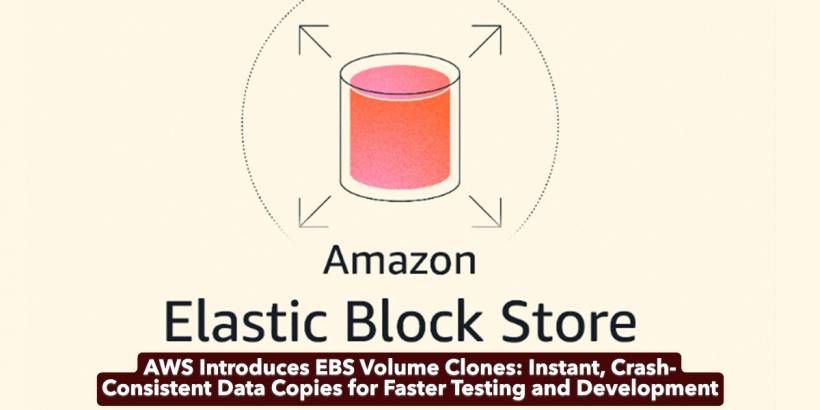Amazon Web Services (AWS) has rolled out a powerful new capability for its Elastic Block Store (EBS): Volume Clones. The feature allows developers and system administrators to create instant, crash-consistent copies of EBS volumes — dramatically speeding up workflows that depend on fresh, production-like data environments.
A New Way to Copy Data Instantly
Traditionally, creating a copy of an EBS volume required taking a snapshot, storing it in Amazon S3, and then creating a new volume from that snapshot — a process that could take minutes to complete. With the new Volume Clones feature, users can now make point-in-time copies of their EBS volumes within seconds, all within the same Availability Zone.
According to Sébastien Stormacq, AWS developer evangelist, this update brings near-instant data access with single-digit millisecond latency, making it ideal for test and development scenarios. Developers can now clone production data to build test environments, stage new deployments, or run data experiments — all without waiting for a full snapshot to complete.
The process is simple: one API call or a quick click in the AWS Management Console instantly spins up a new volume clone.
Integrating Seamlessly with Containers
Volume Clones also tie neatly into AWS's growing container ecosystem. The feature integrates directly with the Amazon EBS Container Storage Interface (CSI) driver, streamlining how storage is managed for containerized applications running on Amazon EKS or Kubernetes.
This integration means teams deploying microservices or stateful workloads in containers can now quickly replicate volumes, test configuration changes, or recover from data corruption scenarios without lengthy snapshot delays.
Praise — and a Little Humor — from the Developer Community
The feature has sparked strong reactions from developers who understand the complexity behind AWS's infrastructure magic.
Luc van Donkersgoed, an AWS Serverless Hero, expressed admiration on LinkedIn:
Others celebrated the breakthrough with a dose of humor. The Snark bot from the "Last Week in AWS" community joked on Bluesky:
Jokes aside, the consensus among developers is that Volume Clones mark a serious technical achievement, offering a level of performance and efficiency rarely seen in traditional cloud storage solutions.
How It Works — and Best Practices
While Volume Clones may look like a shortcut to instant backups, AWS clarifies that they're not a replacement for EBS snapshots. Instead, they complement existing snapshot workflows.
Volume Clones provide crash-consistent copies — meaning they reflect the state of data at a single point in time, even if some in-memory transactions were still in progress. For critical applications, AWS recommends pausing I/O operations before cloning to ensure application consistency. Examples include using pg_start_backup() in PostgreSQL or the xfs_freeze command on Linux to temporarily freeze file system operations.
You can create clones of encrypted volumes within the same Availability Zone, as long as the new volume's size is equal to or greater than the source. Currently, AWS does not allow cloning from unencrypted source volumes — a limitation that has left some users curious about the underlying reason.
Each cloned volume operates independently from its source, incurring standard EBS pricing until deleted. To prevent unexpected storage costs, AWS recommends establishing cleanup rules or automation scripts to manage unused clones.
Availability and Pricing
AWS says Volume Clones are available across all commercial Regions, selected Local Zones, and AWS GovCloud (US). Pricing includes a one-time charge per GiB of data on the source volume at the time of initiation, in addition to standard EBS charges for the new volume itself.
Volume Clones support all current EBS volume types and can be used across any AWS account operating within the same Availability Zone.
Why It Matters
With Volume Clones, AWS is addressing one of the biggest bottlenecks in cloud operations: the time and complexity involved in duplicating data safely. For developers, this means faster testing, easier troubleshooting, and more flexible staging environments. For businesses, it means less downtime and quicker innovation cycles.
The move also highlights AWS's ongoing effort to reduce friction in its storage ecosystem — offering more "real-time" capabilities in a platform historically known for its robust but sometimes complex workflows.
As Luc van Donkersgoed aptly put it, what AWS has achieved here feels a bit like black magic. But for teams working in fast-paced DevOps environments, it's the kind of magic they've been waiting for.




